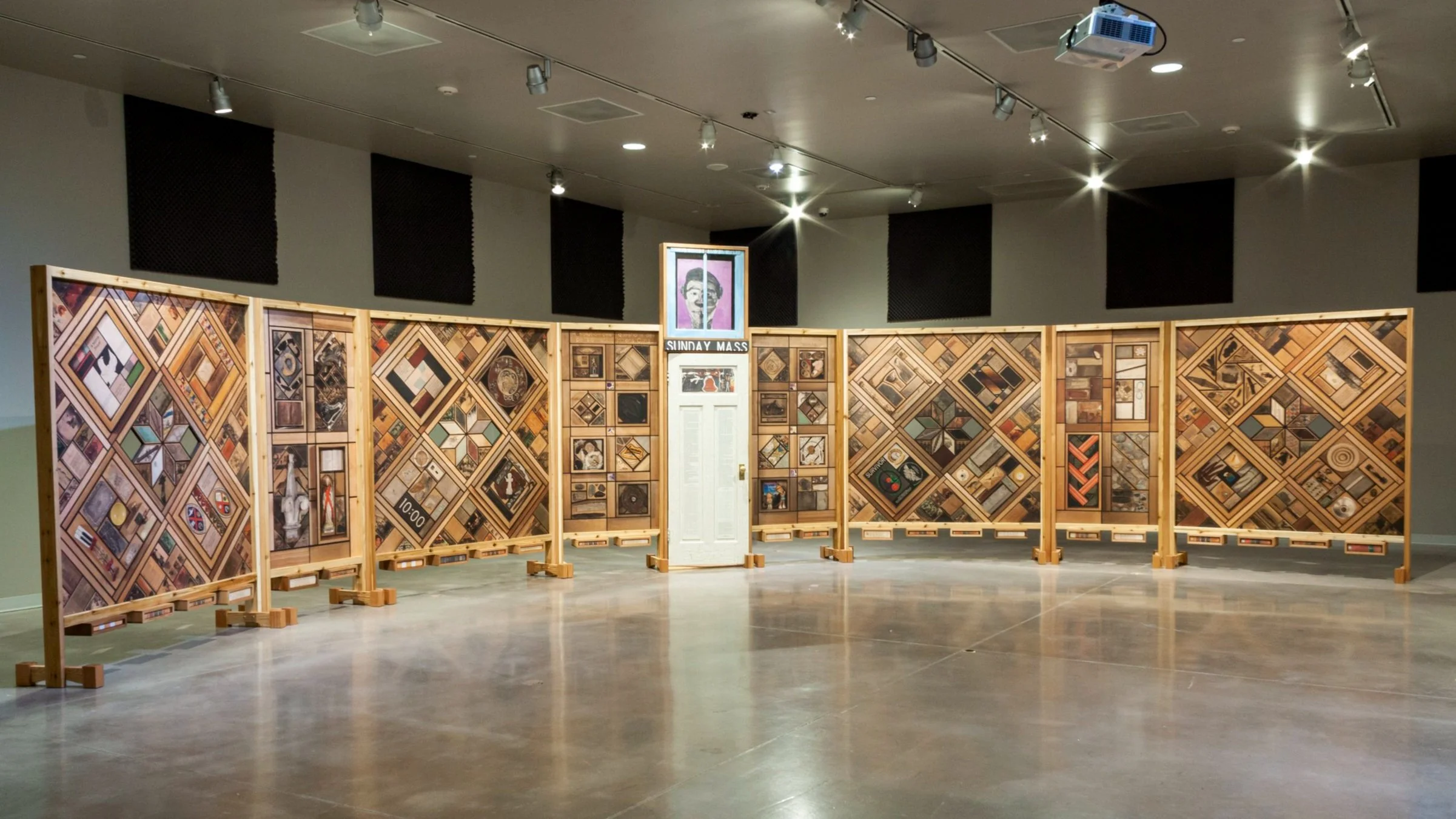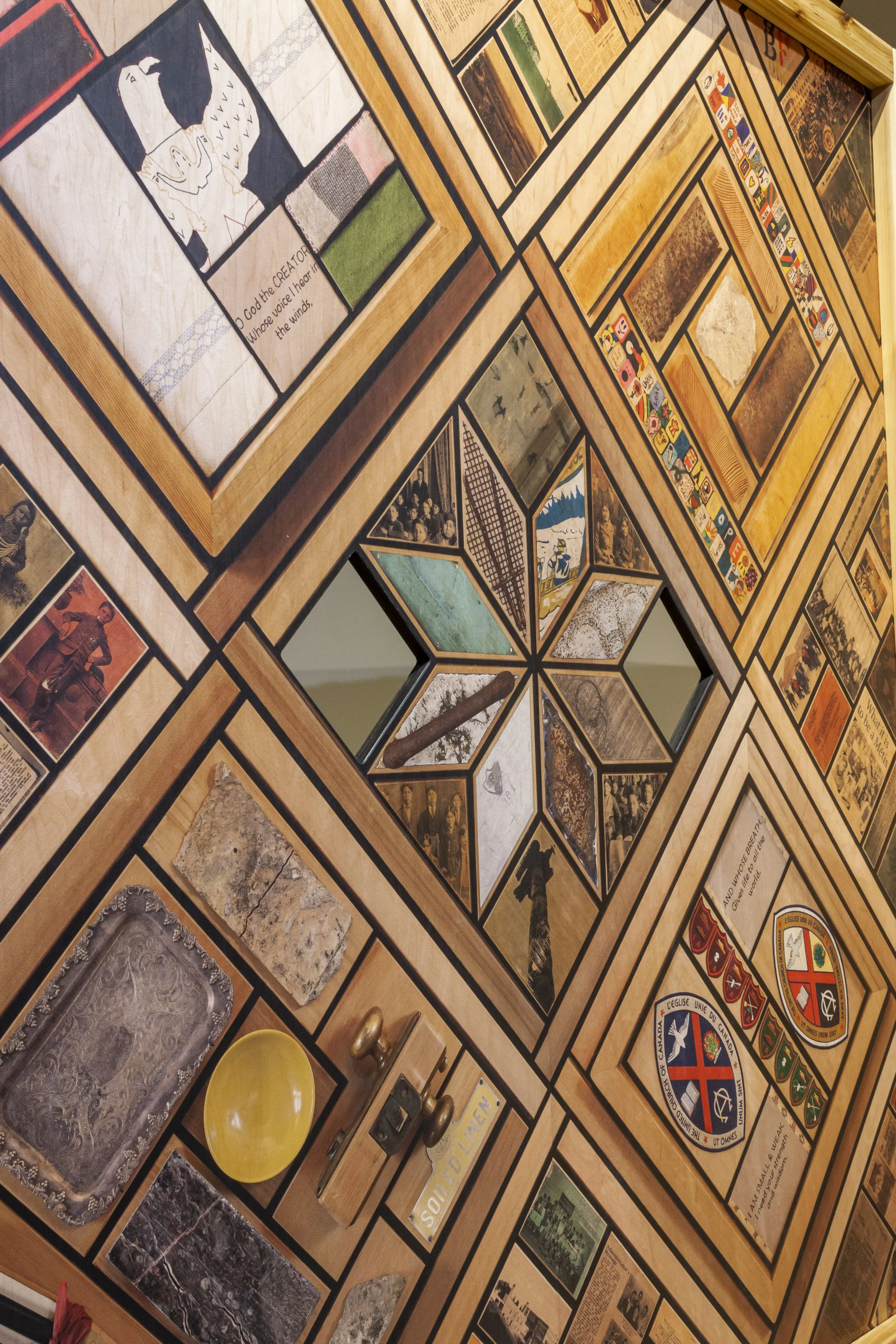Master carver Carey Newman's monumental Witness Blanket tours to the West Vancouver Memorial Library
Artist of Kwakwak’awakw, Coast Salish, and settler descent reflects on impact of large-scale work featuring nearly 900 reclaimed residential-school items
Witness Blanket. Photo courtesy of West Vancouver Memorial Library
West Vancouver Memorial Library presents Carey Newman/Hayalthkin’geme’s Witness Blanket from January 26 to March 10, with an opening reception on January 26 from 6:30 pm to 8 pm
AN INFIRMARY DOOR that was once a part of St. Michael’s Residential School in Alert Bay is now the focal point of master carver Carey Newman’s large-scale art piece Witness Blanket—and surrounding it are nearly 900 other objects reclaimed from residential schools, survivors, churches, government buildings, and cultural sites across Canada.
Measuring in at over eight feet tall and 40 feet long and complete with cedar framing, the Witness Blanket draws its inspiration from the woven blanket, a universal symbol of protection. Newman’s team travelled more than 200,000 kilometres and met more than 10,000 people across 77 communities on its journey to assemble the art installation that offers both harrowing stories of loss and powerful emblems of resilience.
Now, more than 10 years after Newman began working on the project, he tells Stir over a phone call that there’s still plenty to reflect on.
“My dad is a residential school survivor,” says Newman, whose traditional name is Hayalthkin’geme. The artist is of Kwakwak’awakw and Coast Salish heritage on his father’s side, and his mother is of settler descent. “Me and my sisters grew up not knowing much about what his experiences with that were, but knowing that they had a deep impact on him. So when the Truth and Reconciliation Commission released the call for commemoration initiatives, I decided that, as the son of a survivor, I wanted to make something that addressed the schools.”
As visitors bear witness to Newman’s artwork, they unlock the history of each item—letters, photos, stories, books, clothing, art, building fragments, and more. On the left side of the blanket are two braids of hair contributed by Newman’s sisters, Marion and Ellen, in honour of their father Victor. Each of the sisters grew their hair long, braided it, then cut it off in a traditional ceremony. The braids symbolize the grief surrounding the experience of their father, who, like thousands of other Indigenous children, had his hair forcefully cut off by the staff of Sechelt Residential School upon his arrival.
Braid of hair contributed to the Witness Blanket by Marion Newman.
Elsewhere within the Witness Blanket lies a shoe collected from Carcross Residential School in the Yukon—one of the first items Newman’s team sourced for the project. Mossy and tattered, the shoe was found by survivor Harold Gatensby on the grounds where the school burned down in the early 1900s. It’s now encased safely in Plexiglas, bundled with sweetgrass, sage, and red cloth for healing and protection.
There are hundreds more objects to take in: merit badges that were awarded to residential-school students for proficiency in tasks ranging from cooking and sewing to gardening and poultry-raising; a Métis sash representing strength and resilience, contributed by Kamloops nonprofit White Buffalo Aboriginal and Métis Health Society; a stone collected from an Inuvik greenhouse where a residential-school hockey rink once stood. The story of each item is carefully documented, and can also be viewed online in a digitized version of the Witness Blanket.
Newman’s expansive work was first displayed at Winnipeg’s Canadian Museum of Human Rights from December 2015 to June 2016 before embarking on a cross-Canada tour, and then returning to the museum from April 2021 to March 2022 as part of Witness Blanket: Preserving a Legacy. Having undergone a detailed conservation effort to maintain the integrity of its objects, the Witness Blanket will soon be permanently on display at that museum as part of its core galleries.
Witness Blanket. Photo courtesy of West Vancouver Memorial Library
Newman says that the blanket has a different impact on each individual that sees it, depending on their own ties to the residential school system. But as time passes, the project’s purpose is still deeply entrenched in a commitment to sharing the facts.
“We’re getting into the territory where now it’s about countering narratives of denial,” Newman says. “There’s lots of resistance—there’s always been lots of resistance, from some people in society who just don’t want to believe in the truth of the version of Canada that built these institutions. And so they continue to undermine the truth of those experiences, right? So in some ways, this is a material record of that truth. And the stories that are attached to each piece are part of the narrative that supports what survivors have been telling us for generations.”
The edition of the Witness Blanket that’s touring to the West Vancouver Memorial Library is one of two replicas that have been produced of the piece. The door in the centre of the work and the painting of a boy above it (done by Art Thompson during his time at Alberni Residential School) are handmade re-creations of their original counterparts. The remainder of the blanket is an incredibly detailed image transfer printed onto long wooden panels using composite photos of the original Witness Blanket’s objects.
The library is hosting an opening reception for the exhibit on January 26 featuring Chief Chepximiya Siyam’ Janice George, who is presenting a Squamish Nation welcome and blessing for the Witness Blanket. Newman will speak about his artistic process and the integration of technology in modern creations on February 8 from 6:30 pm to 7:30 pm. Plus, the library is running several more events in tandem with the exhibit, including a film screening of Picking Up the Pieces: The Making of the Witness Blanket on February 17, and a Friday Night Concert featuring Indigenous band Diyet and The Love Soldiers on March 8.
“For many years now [the Witness Blanket] has surpassed any expectations that I had for what would come, for how it would be embraced, for the impact it would have,” says Newman. “The fact that there’s not even just one replica, but two; the fact that there’s a feature-length film documentary; the digital Witness Blanket website tells additional stories of experiences; and the VR that we’re building right now. The fact that all of those things have come from this project, it’s more than any artist could dream of.”















